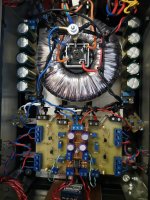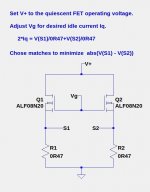Schematic is not really clear.Electrical diagram F7 (probably 90%).
When starting the amplifier, I had problems with establishing a reasonable range of dc offset.
The reason was a loose mounting on the heat sink of one 2sk1058 power transistor. Besides, there were no other difficulties.
D.
cannot be ....isn't pubblished by NelsonSchematic is not really clear.
D.
Maybe I'll just add that I did topology 2 - see @Ihquam # 413
Judging by the sound result of my DIY amplifier, it is very good ... I only want to listen to music and I have no need for further experimentation.
Judging by the sound result of my DIY amplifier, it is very good ... I only want to listen to music and I have no need for further experimentation.
ok, i guess i officially ran out of patience. ill take the F7 off my todo list.
I guess ill add the F6 for completion in 2022 😀
I guess ill add the F6 for completion in 2022 😀
Hi @janf.The power supply includes a 200VA transformer 18Vac-0-18Vac, a rectifier bridge and two 5 x 15mF = 75mF electrolytic capacitor banks. The electric mass is run in a star topology. Guess where the focal point of the electric mass is?
6moons review photos I believe showed the PSU with 6x15mF capacitors in each bank. Can I ask why you used 5x15mF?
The size of the capacitance of electrolytic capacitors results from the current supplied by the power supply to the amplifier.
I assumed a small bias of 0.5A to 0.8A. Regards, Jan
I assumed a small bias of 0.5A to 0.8A. Regards, Jan
I will try to write something more about the sound of the F7, more than the fact that it is 'sensational' - after all, we make various constructions to make it sound well, right?
My first impression, a few hours of listening to the F7 after first turning it on, was that it felt as if the sound was piercing my ears. Then, I noticed that I listened to sounds with great ease, effortlessly, simple, easy and most importantly, pleasant - I realized how much effort I had to put into listening in advance for the brain to produce intelligible and acceptable sonic content of an individual in class individual homo sapiens in the hearing utility category.
If this first listening session was 'in the dark', I would say that the amplifier is tube-type, possibly with some addition of silicon in the pre-voltage. All sounds were reproduced correctly, each instrument played well and freely, with its own expression and dynamics, the amplifier did not allow anything in the soundstage to exist at the expense of something else, which is the main feature of tube amplifiers. But, it was a solid state amplifier, all solid state!
The FIRST WATT F7 by PASS LABS is opening the door to the future of audio in the third millennium.
(Google translate Polish-English)
My first impression, a few hours of listening to the F7 after first turning it on, was that it felt as if the sound was piercing my ears. Then, I noticed that I listened to sounds with great ease, effortlessly, simple, easy and most importantly, pleasant - I realized how much effort I had to put into listening in advance for the brain to produce intelligible and acceptable sonic content of an individual in class individual homo sapiens in the hearing utility category.
If this first listening session was 'in the dark', I would say that the amplifier is tube-type, possibly with some addition of silicon in the pre-voltage. All sounds were reproduced correctly, each instrument played well and freely, with its own expression and dynamics, the amplifier did not allow anything in the soundstage to exist at the expense of something else, which is the main feature of tube amplifiers. But, it was a solid state amplifier, all solid state!
The FIRST WATT F7 by PASS LABS is opening the door to the future of audio in the third millennium.
(Google translate Polish-English)
F7 sound is a lot relate to speaker you connect ,there is a good testing here with some spk, link: F7I will try to write something more about the sound of the F7, more than the fact that it is 'sensational' - after all, we make various constructions to make it sound well, right?
My first impression, a few hours of listening to the F7 after first turning it on, was that it felt as if the sound was piercing my ears. Then, I noticed that I listened to sounds with great ease, effortlessly, simple, easy and most importantly, pleasant - I realized how much effort I had to put into listening in advance for the brain to produce intelligible and acceptable sonic content of an individual in class individual homo sapiens in the hearing utility category.
If this first listening session was 'in the dark', I would say that the amplifier is tube-type, possibly with some addition of silicon in the pre-voltage. All sounds were reproduced correctly, each instrument played well and freely, with its own expression and dynamics, the amplifier did not allow anything in the soundstage to exist at the expense of something else, which is the main feature of tube amplifiers. But, it was a solid state amplifier, all solid state!
The FIRST WATT F7 by PASS LABS is opening the door to the future of audio in the third millennium.
(Google translate Polish-English)
The problem of the necessary amplitude of 2.7 Vac to fully drive F7 was solved by inserting an additional gain stage on operational amplifiers (I used MUSES01, MUSES8820).
I enclose a diagram of this additional circuit k = 3.
Measuring the power of the amplifier on the full signal gave the values 23W at 8.6R and 45W at 4.4R, in both cases the amplitude of the signal at the output was 14.2Vac.
The F7 is great, listening to music gives me a lot of fun! Honestly, I do not want to make other amplifiers, because they are not able to give the quality of the F7.
Greetings,
Jan
I enclose a diagram of this additional circuit k = 3.
Measuring the power of the amplifier on the full signal gave the values 23W at 8.6R and 45W at 4.4R, in both cases the amplitude of the signal at the output was 14.2Vac.
The F7 is great, listening to music gives me a lot of fun! Honestly, I do not want to make other amplifiers, because they are not able to give the quality of the F7.
Greetings,
Jan
Attachments
The second Nils Lofgren certainly brings out the sense of "air" in the music, even in my humble laptop - very nice indeed Big heatsinks and it is surprising how well they still work on their sides!
Having built several F7 clone amplifiers using the ALF08x16 lateral FETs I finally got around to modifying one of those amps to use the ALF16x16 FETs. Only one resistor was changed, but of course the pots needed adjustment. The resistor change was calculated based on the FET transconductances using the equations supplied in post #442 https://www.diyaudio.com/community/threads/first-watt-f7-review.275921/post-4585617.
I found that the increased transconductance of the ALF16x16 FETs make a noticeable improvement to the sound. With the larger TO-264 footprint they could be run at higher voltage and idle current.
I intend to see if I can match pairs of ALF08x16 FETs without current hogging problems to get the same results.
I found that the increased transconductance of the ALF16x16 FETs make a noticeable improvement to the sound. With the larger TO-264 footprint they could be run at higher voltage and idle current.
I intend to see if I can match pairs of ALF08x16 FETs without current hogging problems to get the same results.
I haven't made the measurements yet. Here is the test rig I intend for matching:They have negative tempco.
So you can even parallel without source resistors.
Patrick
Attachments
Unless you want to use source degen, which will reduce gm significantly,
I would move the 2 resistors to the Drains.
Patrick
I would move the 2 resistors to the Drains.
Patrick
You are right. I was just making that change to the test rig schematic.Unless you want to use source degen, which will reduce gm significantly,
I would move the 2 resistors to the Drains.
Patrick
Not only would the gm be decreased, but in the actual amplifier source degeneration would increase higher order harmonics relative to H2 and H3.
Did you changed the value of Rfbp or Rsen ?Having built several F7 clone amplifiers using the ALF08x16 lateral FETs I finally got around to modifying one of those amps to use the ALF16x16 FETs. Only one resistor was changed, but of course the pots needed adjustment. The resistor change was calculated based on the FET transconductances using the equations supplied in post #442 https://www.diyaudio.com/community/threads/first-watt-f7-review.275921/post-4585617.
I found that the increased transconductance of the ALF16x16 FETs make a noticeable improvement to the sound. With the larger TO-264 footprint they could be run at higher voltage and idle current.
I intend to see if I can match pairs of ALF08x16 FETs without current hogging problems to get the same results.
Yup, I changed Rsen. I also "fine tuned" Rfbp to get a high damping factor.Did you changed the value of Rfbp or Rsen ?
- Home
- Amplifiers
- Pass Labs
- First Watt F7 review


